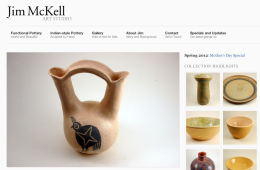
Web Trends and Directions for 2016

By Marc Carson · Tuesday August 18, 2015
[Above: Ukiah, California, Photo by Marc Carson]
Before 2016 arrives, here are my thoughts and predictions on web marketing, web design, and social media. The advice below has been distilled from my work with, and feedback from, various clients.
Marketing you and what you do
- Your message is unique! Expressing your uniqueness and identifying your own gifts, and those of your team, will continue to be crucial.
- There are too many social media sites and channels out there to just pick at random.
- Planning your approach will be more important than ever
- Web marketing strategy is a thing that is done now. If you don’t know what your strategy is, you may “just have a website.” Strategy can be planned and managed top to bottom in an efficient manner. And it is effective.
- Marketing your unique content is still huge.
- Plan it out, write it up, publish it, refine it.
- This doesn’t mean didactic marketing, e.g. “Our CEO’s Monthly Message”
- It’s gotta be helpful and oriented toward the needs of your clients / customers
- Allow them to help you create the content
- Message boards, surveys, etc.
- Traffic generation does often equate to sales.
- Building and refining a sales funnel is crucial.
- Refining the funnel depends on how much data you can analyze.
- Gather, adapt to feedback as part of a scheduled process.
- Generating unique content that you own is worthwhile.
- Your content should be reusable—repackage in the future as ebook, additional channel, etc.
- “Accidentally” publish your first drafts. Do whatever it takes to get your content out there. Make yourself vulnerable.
- Do you know what your visitors are interested in, what they’re responding to? Most websites collect statistics and you should review it.
Working with established social networks
- There are thousands of social networks. It is necessary to think beyond the big five (or six, seven…) to be most effective.
- You can use the web and social effectively to market yourself.
- There is a good way and a bad way to do it.
- You can usually pay for better results, and the results are often worth it.
- Target your campaign well.
- Original, relevant content is appreciated by any audience.
- If your content could be a fit (e.g. recipes to Pinterest, or fashion to Instagram), definitely try networks that you haven’t tried yet.
- If your content isn’t a fit, monitor the channel anyway, watch how it changes over time.
- Follow and be followed. Watch what others do. Participate.
- Don’t let fashion, progression of technology, etc. turn you off. You aren’t too old and it’s not too young.
Adapting to new social networks
- Watch for new changes in existing channels: Even the obscure Facebook Notes, recently updated, might gain new traction.
- Keep using the “old” channels, like email, print, radio…but arrive at the decision by researching your market, not by stubbornness.
- When new channels appear, dive in, participate, assess.
- If you have questions about how people are marketing in a channel, ask rather than assuming
- There will never be too many social networks; recent history has also taught us the value of ad-hoc social networks (from IRC to Facebook Events)
- You’ll have information about “your channels” in your signature line or on your business card for years to come. But keeping Facebook on there will eventually start to look like an AOL username.
Producing mobile web applications
- People are becoming more aware of “mobile web applications” as opposed to just native apps.
- Clients are asking for them, from calculators to PDF generators to recommendation engines to guidebooks.
- People are becoming disappointed with their first-gen native apps (nobody uses them).
- Web applications play very nicely with existing websites.
- Apple is under tremendous pressure to give more freedom to web applications.
- Web applications can now show push notifications.
- Web applications already have access to sensor data like GPS.
- Web applications give more control back to the publisher, authoring, and marketing team.
- They still need to be useful and helpful or they won’t be used.
- The web browser is still the most-used app on smart phones and tablets of any kind.
Search engines: Still important, but troubled waters
- As Google Search remains Google Search, people will naturally start to look elsewhere.
- Privacy concerns are huge and law is backing them up.
- Social marketing has helped lift the web out of the disgusting world of black- and gray-hat SEO into a healthier objective extraversion.
- Search is still crucial, but those who don’t work in it know even fewer of the details now.
Thinking about Design: Still crucial, and even better understood
- Design is now more of a priority than it has ever been, even for the most inexperienced stakeholders.
- Pop culture and advertising are now teaching people design language as they watch TV (Mad Men, Apple commercials, etc.).
- Web surfers understand that refinement is a powerful if subjective measure of design skill, and are more attuned to details than they were in the past.
- Design as “do what’s appropriate given my audience and product/service” rather than “use the latest trend in visual decoration and hop on the latest social network”.
- Wider audience for relatively new aspects of design, such as user experience (UX).
- More focus on identifying existing web design patterns rather than trying to roll-our-own-everything (NIH syndrome).
Conclusion
The web is handling the need for change very well. If you don’t have time to keep up, make it a priority to find people and resources that can help you navigate the changing landscape. If you do have time to keep up, it’s an extremely exciting time.
FOMO (fear of missing out) can make people want to jump from platform to platform, but it is crucial for teams to identify and work against broader standards and focus the details on areas where they have the most leverage, i.e. content-focused vs. delivery-technology-focused.
Overall, my bets are on original content and establishing a self-owned space online. Those will be beneficial forever. Maintaining the funnel that takes people to that is an ongoing process.
Latest Bookmarks
- Cool, but obscure unix tools →
- Cool Gifs →
Watch a bunch of interesting animated gifs scrolling by. - Wonders of Street View →
View some interesting finds on Google Street View. - pppalette, your friendly color palette generator →
Various color palette generation tools. - What to Watch on Youtube When Bored →
Has a "roll" button that opens a new tab with a different Youtube search term.
- Dungeoneers Game →
Play a well-crafted dungeon crawl game. - Radio.Menu →
Listen to internet streaming radio stations online. - Ocearch Marine Animal Tracker →
OCEARCH Shark & Marine Animal Tracker - Burner Note →
Send secure and encrypted notes that self destruct once they've been read. - cli-ck →
Tips and tools for text mode lovers

